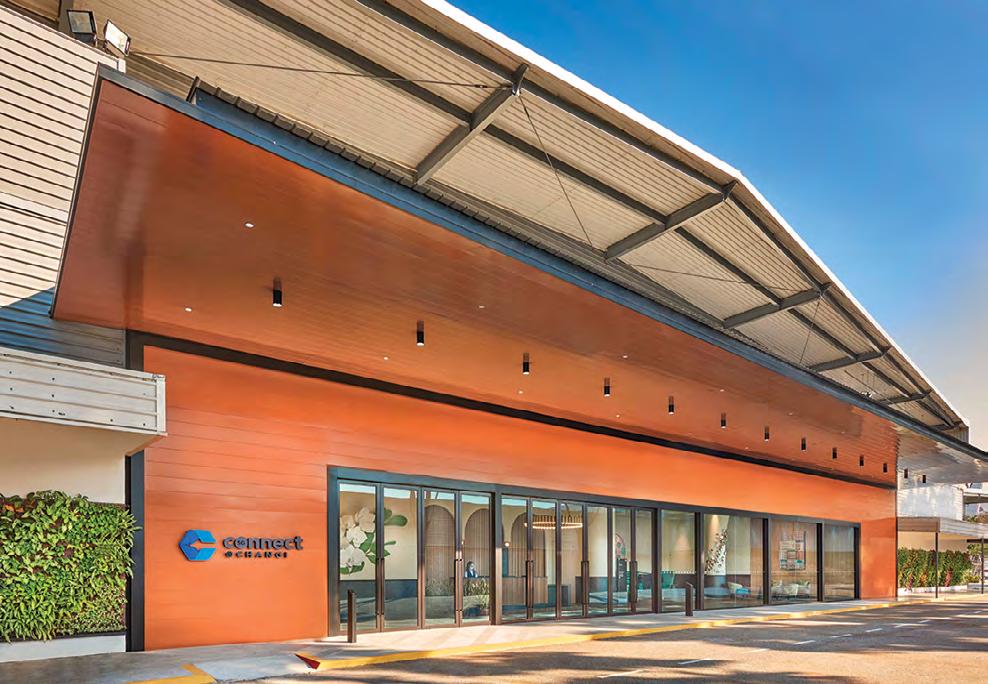
8 minute read
Reducing seismic risk with strengthening systems based on FRP composites and applied externally only Experimental work has validated the benefits of this innovative approach
REDUCING SEISMIC RISK WITH STRENGTHENING
SYSTEMS BASED ON FRP COMPOSITES AND APPLIED EXTERNALLY ONLY
by Prof Alberto Balsamo, Department of Structural Engineering and Architecture, Federico II University of Naples, Italy and Giulio Morandini, Corporate Product Manager, Structural Strengthening Line, Mapei SpA, Italy
Experimental work has validated the benefits of this innovative approach.
The vulnerability of the current building stock was highlighted again in Italy by recent seismic events which, inevitably, took a heavy toll in terms of the number of victims and the amount of material damage. Making structures safe, therefore, is a priority in social and economic terms, in order to improve the level of safety in homes and to reduce economic loss. In this context, priority must be given to developing and validating low-impact interventions that can be adopted quickly and minimise application times and costs, with the aim of upgrading the current building stock, whether they are used on just a single structure or implemented on a much larger scale. The test campaign illustrated in this article analysed the behaviour of a structural sub-assembly consisting of a beam-column joint in its original configuration and when strengthened with externally-applied FRP (Fibre Reinforced Polymer) systems. This configuration was chosen to minimise the amount of disturbance to the occupants of the building and to avoid having to remove portions of the infill walls, making it less invasive and more cost-efficient. The experiment demonstrated the effectiveness of the technical solution proposed to overcome one of the main structural deficiencies in existing reinforced concrete buildings, that is, the triggering of brittle failure mechanisms (shear failure) in non-confined joints, such as wall and corner joints. Development of this innovative strengthening method is a result of the close relationship between Mapei SpA and the DiSt (Department of Structural Engineering and Architecture) of the Federico II University of Naples, and the work carried out to develop and validate sustainable solutions using innovative materials in the building sector. Intense, experimental research work is conducted constantly to evaluate the effectiveness of cutting-edge systems to reduce seismic risk in reinforced concrete and masonry structures. Composite materials have shown to be particularly beneficial in mitigating seismic risk because they combine an increase in a structure’s ability to withstand seismic loads with the low impact (and invasiveness) their application has on the structure. They are applied mostly externally and treated as a localised intervention. When applied to reinforced concrete structures for seismic purposes, composite materials have proven to be beneficial in eliminating brittle failure (tensile failure in joint panels, for example) which is typically responsible for much lower safety indexes than those specified when designing new buildings (Figure 1). FRP strengthening systems applied to non-confined joints may be combined with localised shear-strengthening on those elements which tend to be more vulnerable in the event of seismic activity, such as short pillars, which have been found to suffer more damage, following seismic activity.
EXPERIMENTAL WORK
The experimental test campaign was conducted in the DiSt test lab to experimentally confirm the validity of a new FRP strengthening system designed to increase the seismic capacity of non-confined beam-column joints in reinforced concrete. The advantage of this type of system is that it only needs to be applied to the outside of the building, without having to remove sections of infill walls.
Test programme and method
The experimental test campaign was carried out on two beam-column joints - the first one in its original, as-built configuration and the second one in a strengthened configuration. The two sub-assemblies were geometrically identical and were made from materials with identical mechanical properties and reinforcement. They were representative of reinforced concrete buildings typically found in medium-risk seismic zones and were designed according to construction norms and standards which are now obsolete. They were characterised by their lack of stirrups in the joint panel and deficient transversal reinforcement in the beams and columns. The columns were 300 mm square and reinforced with eight pieces of Ø 16 mm rebar, while the beam was 300 mm wide, 500 mm deep and reinforced with three pieces of Ø 16 mm rebar along the upper and lower sides. The tests were carried out using the set-up shown in Figure 2a, by applying a constant, normal load at the top of the pillar and a cyclical shifting load of increasing magnitude at the end of the beam. The loading protocol is shown in Figure 2b as a function of equivalent inter-storey drift.
Figure 1: Shear failure of beam-column joints following seismic activity.
External strengthening system with FRP
The new system was based on the use of innovative anchoring systems (Figure 3) to replace traditional binding with uniaxial CFRP fabric wrapped around the beam in a U formation (Figure 4). According to criteria adopted to verify the strength of beam-column joints (NTC- Italian Technical Standards for construction - 2018, section 7.4.4.3.1), the resistance of beamcolumn joints following diagonal cracking may be entirely guaranteed by stirrups applied horizontally. The effect of the stirrups, which were not present on the joint under examination, was provided by an equivalent FRP strengthening system applied externally, consisting of quadriaxial carbon fibre fabric applied on the non-confined angle joint to prevent brittle failure in the joint panel in favour of more yield in the horizontal rebar in the adjoining beam. The FRP strengthening may be calculated as follows: • In accordance with the CNR DT-200/2004 and CNR DT200R1/2013 instructions by the Italian Research Committee, the Guidelines of the Italian Supreme Council for Public Works of 24.07.2009, and the Guidelines for the Repair and Strengthening of Structural Elements,
Buffer Walls and Partition Walls (ReLUIS - Italian
Seismic and Structural Engineering University Labs
Networks - 2011). • By calculating the main stresses/strains (used when designing experimental tests), taking into consideration the beneficial effect of a normal force and the contribution provided by the concrete (refer FIB BUL-
LETIN No 90: Externally-applied FRP reinforcement for concrete structures). Figures 5a, 5b, 5c, 5d, 5e, 5f and 5g show the main application operations and the materials used in the strengthening package (for external applications only).
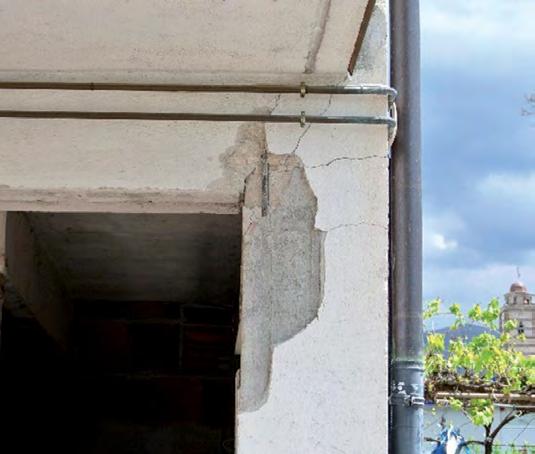
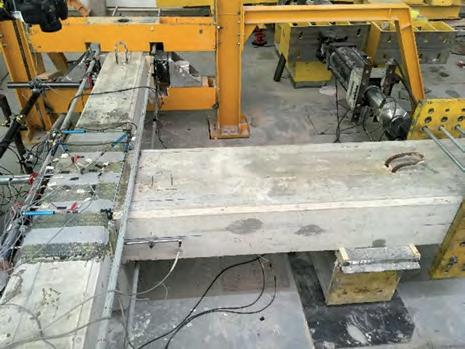
Figure 2a
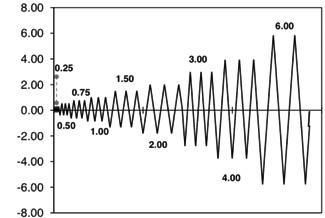
Figure 2b
EXTERNAL APPLICATION ONLY
uniaxial SFRP
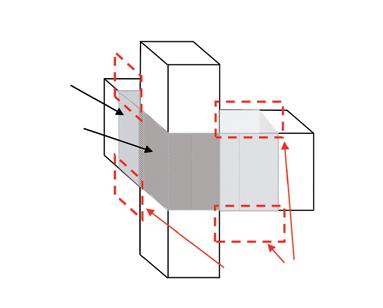
quadriaxial CFRP

No demolition of infill wall required
Figure 3: Diagram of an FRP strengthening system (joint panel only) - external application only.
TRADITIONAL APPLICATION
uniaxial CFRP
quadriaxial CFRP
Portions of infill wall to be demolished
Figure 4: Diagram of an FRP strengthening system (joint panel only) - traditional strengthening system.
Figure 5a: Drilling a series of Ø14 mm holes for the anchors.
Figure 5g: Overview of the strengthened joint, showing the anchoring strips wrapped over the MAPEWRAP C QUADRI-AX 380 SYSTEM. Figure 5b: Pre-consolidating the surface of the concrete by applying a twocomponent, solvent-free, epoxy resin primer (MAPEWRAP PRIMER 1).
Figure 5f: Applying, by trowel, a layer of two-component, thixotropic epoxy putties (MAPEWRAP 11/12) for the anchoring strips. Figure 5c: Smoothing over the surface of the concrete by trowel-applying two-component, thixotropic epoxy putties (MAPEWRAP 11/12). While the smoothing compound is still fresh, apply the first layer of a medium viscosity epoxy adhesive (MAPEWRAP 31) with a roller, to impregnate the FRP fabric applied to the two external faces of the column.
Figure 5e: Filling the holes for the anchoring system with solvent-free, pure epoxy resin chemical anchor (MAPEFIX EP 470 SEISMIC). Figure 5d: Applying the MAPEWRAP C QUADRI-AX 380 strengthening system (in compliance with CVT Technical Evaluation Certificate n° 206/2019 - Class according to the Guidelines of the Italian Supreme Council of Public Works n° 220, 9.7.2015: 210C) consisting of quadriaxial, high modullus of elasticity, high-tensile strength, balanced carbon fibre fabric, and medium-viscosity epoxy adhesive (MAPEWRAP 31), and broadcasting the surface with quartz sand.
Experimental validation
The effectiveness of the new system was demonstrated by comparing the results of the experimental test campaign in terms of the cyclic response (Figure 6) and by crackmapping analysis as drift demand increased (Figure 7). The failure mode of the as-built joint was typical of the type found in existing buildings with diagonal shear cracks in the joint panel. Cracking appeared at a moderate inter-storey drift demand of around 1.00% (Figure 7). This type of cracking precedes flexural yield of the rebar in the beam (Figure 6). According to NTC 2018 construction norms, this type of shear cracking phenomenon (brittle failure mode) indicates that the life-saving state (LSV) has been reached. This significantly reduces the capacity of the entire structural system and would lead to very low estimated LSV safety indexes. The joint strengthened with FRP, applied externally only, demonstrated the effectiveness of the strengthening system. The overlap in the experimental curves in Figure. 6 shows that initial stiffness is more or less similar to that of the as-built joint, which demonstrates that this type of intervention may be considered to be of the ‘localised’ type. The effectiveness of the intervention was confirmed by it fulfilling the main objective - to modify the failure mode from brittle-type (shear failure in the joint panel) to ductile-type (flexural yield of the beam). An analysis of the results shows that the amount of energy dissipated increased significantly (+30%), leading to an increase in the performance characteristics and seismic capacity of the building. The strengthening system was able to withstand these types of load until it reaches a drift demand of 2.00% with evident flexural cracking in the beam (Figure 7). The experimental tests clearly demonstrated the effectiveness of this new strengthening system, which increases the shear strength of the joint panel and favours the development of ductile yield failure in the beam. This results in a significant increase in the amount of energy dissipated, leading to an increase in the performance characteristics and seismic capacity of the building.
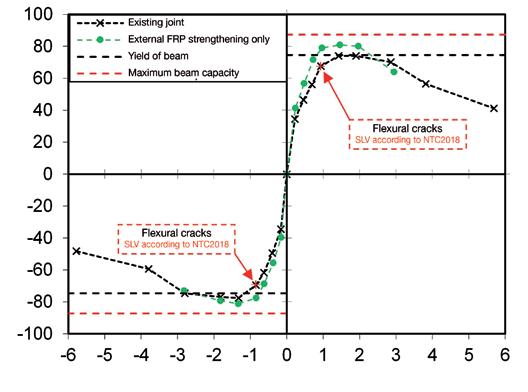
Figure 6: Comparison of the experimental values.
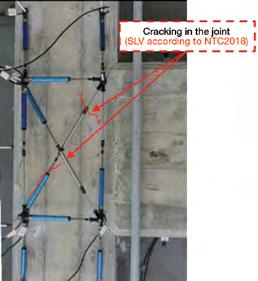
Drift 1.00%
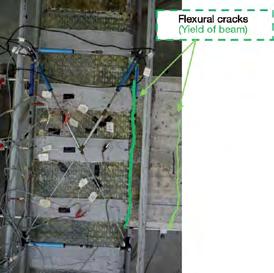
Drift 2.00%
Figure 7: Comparison of crack phenomenon at different levels of inter-storey drift.
This editorial feature is based on an article from Realtà MAPEI INTERNATIONAL Issue 84

